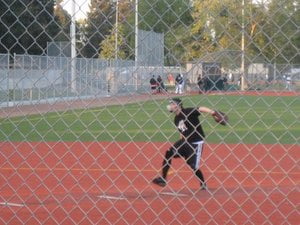In slow pitch softball, the pitcher can make a big difference on whether a team wins or loses. By having a smart one who knows what he is doing, along with a solid defense, you will win your share of games. I’ve seen plenty of pitching articles about how to be a slow pitch softball pitcher. They are informative as they show you how to grip the ball for different pitches. However, just because you know the proper grip doesn’t mean you’ll be able to execute the pitch in the game. The following is some non mechanical tips, that any pitcher can use, regardless of skill level.
1. Pace
This is a very simple thing you can do to help yourself out no matter what your skill level as a slow pitch softball pitcher is. What I mean by pace is to vary the time between when you actually make the pitch. So for example, as the batter gets in the box, pitch the ball quickly to take him by surprise. Just make sure the batter is in the box, otherwise the umpire might call it an illegal pitch. Then on another pitch, hold the ball longer than usual, as this can freeze a batter while he waits longer than anticipated for the pitch to come. Be sure not to hold it too long or the batter might call for time and step out of the box. In general an extra 3 seconds longer than you would have normally taken is good. Otherwise, the umpire might get upset at you for taking too long. Which brings me to my next point.
2. Don’t Cross the Umpire
I cannot stress the importance of this enough . As a slow pitch pitcher, keep in mind that you are playing in a recreational league. You are not a professional and neither is the umpire. Therefore, there are going to be some close calls (and sometimes obvious calls) that don’t go your way. Complaining about it, and/or displaying bad body language about it is only going to make the situation worse. Let the other team be the one to complain about close calls and you’ll probably end up getting more in your favor as the game goes along.
3. Release Angle
Changing the angle of where you release the ball is another way to prevent hitters from seeing the same pitch time after time. You can do this by just standing on different sides of the pitching mound. As long as you are within the width of the mound you are still pitching legally. As a right hander you can really get a sharp angle by throwing off your left foot (instead of the normal right). Touch the tip of your left toe to the right edge of the mound. Lean as far as you comfortably can toward the 3rd base side. Now when you release the ball it will practically be starting out behind the hitter.
4. Push the Ceiling
In most slow pitch leagues, the height regulations are from 6 feet at the floor to 12 feet at the ceiling. In general, the higher the strike, the better. Each umpire’s interpretation of what 12 feet is can vary a lot. Therefore, it is important to test the ceiling early in the game to get an idea of how high the umpire will allow you to go. I make it a point to get a few pitches called illegal each game as a reminder to make sure I’m throwing it nice and high. Often times, if you throw one ball that is in the zone but it gets called too high, and then throw it the same spot on the next pitch in the zone, you’ll get the call. So keep throwing it high as you can because most umpires won’t continue to call everything illegal, especially when you display control.
5. Vary the Height
While a slow pitch pitcher should get the ball as high as he can, it also helps to mix up the level once a good height ceiling is established. I vary the heights the most after I get ahead in the count with a first pitch strike. This is a great time to come back with a pitch that is not a strike and much lower than your previous pitch. What this does is just give the hitter a different look at how long the ball takes to come down into the hitting zone. Two positives can come out of this. For one, the batter might just swing because he’s behind in the count and doesn’t want to strike out. That is already a victory because he’s swinging at a bad pitch to hit. Or two, if the hitter doesn’t swing at the pitch, you still have 2 pitches to work with and can come back with a much higher one. After just seeing the low one, the batters timing now may be a hair off.
6. Stay cool
In slow pitch softball, you are going to give up some runs as the pitcher. If your opponent is decent at all, they’ll have their innings where it seems nobody is going to make an out. Remain calm and don’t rush things. Pitchers have a tendency to quicken the pace when things go bad because they want to hurry up and get the next guy. This is a mistake. If you’ve give up a few hits in a row, take a few steps away from the mound to give yourself a moment. Regain your focus and just concentrate on the next pitch. Thinking about how bad the inning is going will only add to the fire.
7. Support your Teammates
Nobody is perfect and as a slow pitch softball pitcher you should remind yourself of this before every game. When somebody makes an error behind you don’t get on your teammate about it and don’t react in a negative way. This is only going to make the player feel worse than he already does. Instead, let him know, “hey don’t worry about that, I’m going to pick you up by getting this next guy”. As the pitcher, you are the leader of the defense and showing that support can, believe it or not, make your defense play better.
8. Know your opponent
After playing in your local leagues for a while you should begin to learn some of your opponents skill level. Use this to your advantage by being more careful with the more dangerous hitters in the league. It’s also equally important to know who the weak hitters are and go right after them. Don’t try and throw the perfect pitch to these hitters because before you know it, you could be walking the easiest out on the team.
9. Know the Game Situation
In slow pitch softball, pitching according to the game situation can also make a difference in winning or losing. For example, in most co-ed leagues, if a male batter is walked with 2 outs the female on deck gets an automatic walk. Therefore, by walking a male with 2 outs you are allowing two runners to reach base for free with another male batter coming up. In men’s leagues, there are situations that can call for a hitter to be pitched more carefully and other times when the pitcher must go right after the hitter. For example, never walk the leadoff hitter no matter how good he is. A leadoff walk will end up in that batter coming around to score in most situations anyways. On the other hand, if there are 2 outs and the guy coming up is a great hitter, it is a good time to pitch around him. If he wants to chase after a pitch out of the strike zone, it is a victory already. If you end up walking him, then its just a man at first with 2 outs.
10. Be Vocal
In slow pitch softball, defensive positioning and strategy go a long way. As the pitcher, you should know best where the batter tends to hit the ball. You also know the location of where you intend the pitch to be. Use this knowledge to make sure the your defense is properly placed. When a new hitter comes up, turn your head and see where your defense is. If you can tell an outfielder is playing too far back, or too shallow, let him know. Many softball hitters aren’t good at placing the ball where they want to and just swing away. This can allow you to predict the area where the ball might land. Making sure your defense is properly aligned can turn a homerun into an out.
So there are the 10 tips that will make you a more successful slow pitch softball pitcher. None of them require you to know how to throw a trick pitch, or be at a high skill level. Apply these tips and you’ll become a more successful pitcher. Good luck and have fun out there!




